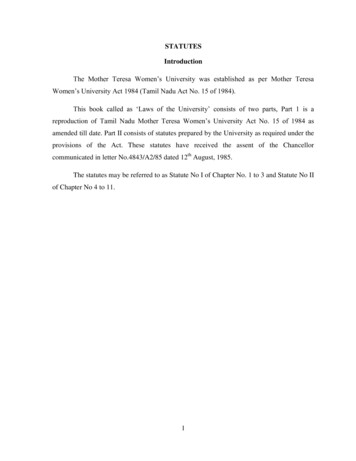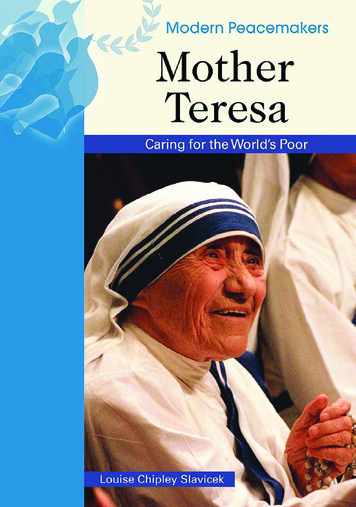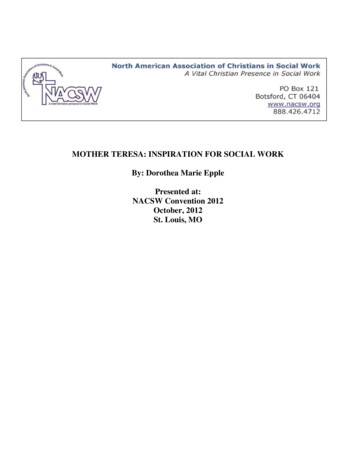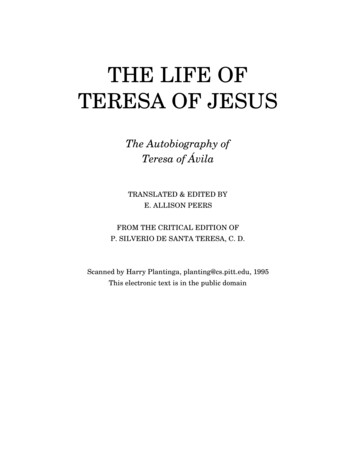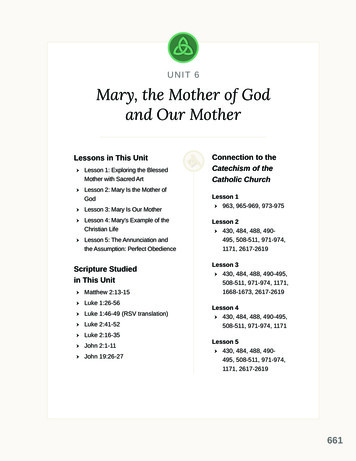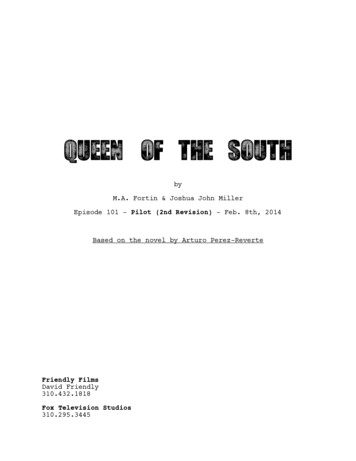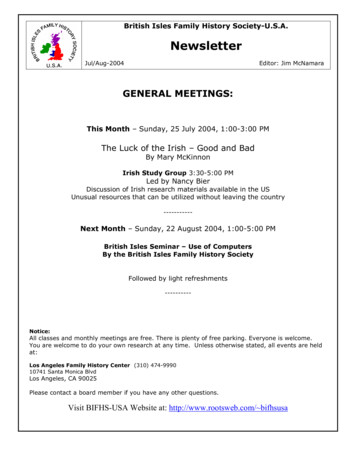
Transcription
NEWSLETTER3rd May 2021To All In Our Learning Community,This coming Wednesday night is our information night for Foundation children 2022 is to take place. TheFoundation information night each year provides me as principal with another opportunity to reflect on what we areabout at Mother Teresa PS. What is it that is important to us as a Catholic learning community in the 21st century?What is it that makes our learning community unique? Apart from the physical layout of flexible learning spacesthat for some make us different, the terms, and implications of being a Catholic Dialogue school, Culture of Thinkingand Community of Inquiry capture our difference and our hope for all learners.Through the many and varied learning opportunities provided to our children each learner is given time andopportunity to develop and consolidate learning and to articulate their thinking. Opportunities to inquire intopassions and to be guided through inquiries results in high levels of engagement. Learning is lifelong and life wideand our hope is that learners develop the skills and dispositions that assist them to be lifelong learners.My reflections also bring me back to some key ideas and quotes from both theologians and educationalists,in particular the work of Pollefeyt & Moyaert and Vygotsky and Ritchhart. The research of these scholars hasimpacted on our Catholic Dialogue School, Culture of Thinking and Community of Inquiry and is captured in thefollowing:“The end product of Catholic education is not the perfectly socialized pupil, but a pupil who is ableto inquire into everything and everyone positively and with an open mind, inspired by a profoundsense of humanity and by a connection with old and new stories which can open alternative worldsand which grant the future a utopian orientation (i.e. the promised land, kingdom of God)”Pollefeyt & Moyaert 2004“ human learning presupposes a specific social nature and is part of a process by which childrengrow into the intellectual life of those around them (Vygotsky, 1978).“For classrooms [learning spaces] to be cultures of thinking, schools have to be cultures of thinkingfor teachers”Ron RitchhartIt is my hope and that of staff that children and parents who make up our learning community and those who wish tojoin us experience the richness of learning opportunities provided and are able to remain open minded in our multifaith and culturally enriched society.Kind regardsChrisThis Week’s HappeningsMonday 3rd MayWelcome Colleen MonaghanTuesday 4th MayProfessional Learning - Reporting preparation3/4 excursion – La Trobe Wildlife SanctuaryWednesday 5th MayWelcome Kath MurdochProfessional Learning Faith and Life inquiryFoundation 2022 Information Night 7pmThursday 6th MayFoundation 2022 ToursFriday 7th MayMother’s Day Stall
Welcome Murrundindi2022 Foundation Enrolments SiblingsCurrent school families with a child to begin school in 2022 are asked to contact reception to collect anenrolment form or go onto the schools website to download the enrolment form. Ongoing enquires forFoundation in 2022 indicate a high demand and we do not want to miss current families.Information Night Foundation Enrolments 2022Our information night for Foundation children 2022 will take place on Wednesday 5th May at 7.00pm.On this Information Evening parents will be given information related to curriculum, schoolorganisation and the enrolment process.Families who wish to enrol their child at Mother Teresa Catholic Primary School are encouraged toregister their interest for the evening and to book a tour time to see our learning community in action.For tour times refer to the webpage section: Enrolment Information/Book a TourPlease let your friends and neighbours know of this date.Eucharist Preparation and CelebrationOur Year 4 and Year 5 children are to receive First Eucharist Saturday 19th June, 2021. The celebrationwill take place at Our Lady’s Church, Craigieburn. We are awaiting further details about the numberspermitted at public religious gathering. As the time draws closer we will clarify if attendance can bemore than immediate family members. These details will be provided at our Eucharist workshops inTerm 2.The allocation of times for the First Eucharist celebrations are: Year 4 children at 1pm and Year 5children at 3pm.School Fees Term 2Term Two school fee account of 500 will be forwarded to families on Monday 10th May 2021 and aredue for payment by Friday 21st May 2021. Please check your child’s bag for the school fees statement.School fee payments can be made via credit card, cheque or cash.A direct debit arrangement can also be made.The school account payment details are: BSB 083 347 Account 82676 1906; Mother Teresa CatholicPrimary School, NAB.Please ensure you place your Family name to transaction so we can match your payment!Our school does rely on school fees for many recurrent costs so prompt payment is appreciated.Mother’s Day Stall Friday 7th MayThe Parents and Friends have organised a Mother’s Day stall. Children can buy a gift for their Mother,Grandmother or another significant mother figure. All gifts are 5. Children are required to bring theirmoney in a marked envelope with their name, the amount of money and Learning Space clearly labelled.Mother’s Day Opening Day Monday 10th MayThis year we are inviting mums to visit their child/ren to engage in a learning task with them for a ½hour window on Monday 10th May. Mums are invited to register a time via the Try bookings systemwith the details below:Parents & Friends NewsMother’s day stall helpersOur Mother’s day stall is to take place this coming Friday between 9.00am – 11.00am. If you are ableto assist with the sale of gifts please leave your name at reception – we only require 7 helpers on theday.
What’s Happening in the Learning Spaces“Parents should be educated in the language of schooling, so that the home and school can share theexpectations, and the child does not have to live in two worlds – with little understanding between thehome and the school”. John Hattie, 2009Foundation – Year 2 Learning SpacesAs inquirers we are tuning in to our compelling question, Living Things: Where do they live? Howdo they grow? How do we know? Throughout the term we will develop the following understandings: Living things change overtime. Living things have a variety of external features. Changes in the environment can affect the habitats of living things. Living things live in different places where their basic needs are met.As a way to stay curious about what we are learning, each weekwill have the opportunity to listen to a variety of clues and activateour prior knowledge to predict what might be inside a box.As inquirers we will be tuning in to the upcoming excursion tothe Melbourne Zoo by considering what it means to be a wildscientist. We will have time and opportunity to observe images ofscientists and use our four senses ‘hear, smell, touch and see’ toconsider living things in our environment and their needs forsurvival. We will engage in dialogue about the skills of aresearcher and how we can apply these during the excursion.As mathematicians we are tuning in to the concept of Location.As thinkers, in foundation we will begin to identify positionallanguage such as ‘next to, in front of and behind.’ In year one we will give and follow directions aroundfamiliar locations and in year two we will interpret features of a map by reading a key and identifyingsymbols. We will all be exposed to a variety of different maps including the map of the Melbourne Zooas we plan the direction that we follow throughout the day.As readers we will continue to be exposed to variety of non-fiction texts. We will have time andopportunity to engage in shared reading focus groups as we listen and observe what good readers do andidentify text features. In foundation we will continue to identify our sight words in these texts. Many ofus will continue to consolidate onset and rime and apply this strategy to read unknown words. In yearone and two we will locate and interpret information in texts and share our discoveries in different ways.As writers we will be provided with time and opportunity to engage in Writers Notebook as we findout new ways to express and make our thinking visible. We will observe our teachers as they modelhow to use a writer’s seed. As thinkers we will engage in writing conference groups. Ascommunicators we will engage in dialogue to identify the good in our writing and develop goals thatwe can work on to extend our writing skills.As people of a faith learning community we have listened to the scripture story, ‘The Walk to Emmaus’from the Gospel of Luke (24:13-35) during prayer time and within our learning spaces. As thinkers wewill continue to use the colourful semantics to identify; ‘who, when, where and what doing’ to developour understanding of the text. We will also have time to reflect on the words of the ‘Our Father’ prayerby considering which words, phrases and sentences capture our attention during prayer in our learningspaces.PM eCollectionAs readers, we will be continuing to engage in PM eCollection to help us consolidate readingbehaviours we have learned. We encourage all children to continue reading these books at home, as wellas the books they bring home each night.
Home LearningStudents are encouraged to continue to engage in home learning each night. It is expected that studentsare engaging in reading, counting tasks and sight words practice at home every night. Parents are askedto sign their child’s reading log and counting sheet each night indicating that the home learning tasks arebeing completed. By the end of Term 2, Foundation students are expected to know 150 or more sightwords.Physical Education Day ChangesPlease note following changes to Physical Education Days: On Tuesdays, Learning Space 3 will needto wear their sports uniform and on Wednesdays Learning Space 1 will need to wear their sportsuniform.Year 3 – 4 Learning Spaces“The term ‘hermeneutical’ implies that the Christian tradition, in its different interpretations, is alsopresent in religious education. It is not only through communication that children and adults freelyexpress what they think about religion. It also includes critical interpretations of the Christiantradition and its elements that the participants in the religious educational process have alreadyintegrated into their own worldviews.”Annemie Dillen (2007)As a faith learning community, we will have time and opportunity to activate our prior knowledgearound the names we think are given to the Sacrament of Eucharist. As a way to explore further, wewill read and view the text ‘Friendly Guide to Mass’ - ‘Sacraments of Many Names’ to find out aboutthe meaning of Eucharist and what other titles it is referred to. We will also find out about thestructure of Mass and the symbols and sacred objects of Eucharist. As readers and hermeneuticalthinkers, we will dialogue with others about our interpretation of the text. As part of making ourthinking visible we will engage in the thinking routine ‘Peel the Fruit’ and use the key thinkingmoves - noticing, wondering, explaining, connecting, reasoning, perspectives and capturing theheart.Last week, some of us had the opportunity to visit the La Trobe Wildlife Sanctuary to find out aboutour compelling question how are living things connected. As researchers, we had time andopportunity to engage in 4 workshops to make discoveries about different environments and theconnections living things have to these. We used the thinking routine, Take Note, to identify the mostimportant point and what we found interesting. As thinkers, we will reflect critically about ourselvesas communicators and researchers, by self assessing our scientific skills. We had time andopportunity to engage in a self assessment prior to our excursion to LaTrobe Wildlife Sanctuary andwe now have the opportunity to reflect afterwards, to see how our thinking about these scientific skillshas changed.In mathematics, we will be exploring the mathematical concept of transformation and symmetry,while making connections to our understanding different environments support the survival ofdifferent living things. As researchers, we will look closely at images of nature to identify symmetrical
patterns in natural environments. We will also identify and describe slides and turns found in thenatural and built environment. As we engage in this learning, we will find out about and use newmathematical language such as slide, flip, half turn, quarter turn, reflected, rotated and rotated todescribe and explain our thinking.Year 5 – 6 Learning SpacesIf we use Making Thinking Visible practices to actively engage our students with each other, withideas, and in action, then students will experience deep learning, be more engaged in their learning,assume more active roles in their learning, develop as thinkers and learners, and improve in learningoutcomes.Ritchhart & Church 2020As part of our Faith and Life inquiry understanding, Living things have structural features andbehavioural adaptations that help them to survive in their environment, we engaged in the thinkingmoves activating prior knowledge, making connections and identifying new ideas as we exploredthe digital webinar Animal Classification and Adaptations, an online workshop, with a Zoo expert. Ascommunicators and collaborators throughout the workshop and as part of finding out we engaged indialogue and identified what adaptations different animals have to help them survive and what threatsthey are facing in the wild. We discovered how animals can adapt their behaviour to ensure speciessurvival. As scientists we discovered how to observe the structural and behavioural adaptations ofanimals and the impact of humans on places and habitats.As part of sorting out the changes in our thinking weengaged in the thinking moves making connections,exploring complexities and raising questions anddocumented our thinking about the word adaptation throughthe thinking routine Making Meaning.As readers and critical thinkers, as part of finding out, we will be reading and viewing a variety ofinformative texts to build our schema. As readers we will identify the structural features that assistus to navigate these texts including table of content, headings, subheadings and glossaries. As partof sorting out our thinking, as researchers, we will engage in the thinking moves making connectionsand identifying new ideas as we organise and summarise the information we gather from print anddigital sources. As part of our Home Learning we can engage in the thinking moves activating priorknowledge, making connections and identifying new ideas as we read a variety of digital texts aboutzoo animals on the following websites.Melbourne Zoo website https://www.zoo.org.au/melbourne/habitats/Kids News https://www.kidsnews.com.au/?s zoo animalsAs part of tuning in we will be engaging in a written mathematical pre-assessment related to theconcept of location. In particular we will focus on the thinking moves activating prior knowledge andmaking connections as we document our current understanding related to using a grid referencesystem to describe locations, describing routes using landmarks and directional language andmarking points on a graph using coordinates. As part of finding out and identifying new ideas wewill engage in a variety of learning opportunities including using a variety of digital resources. OnWednesday we will be engaging in our second Maths Olympiad and Maths Game competition. Thisis an opportunity for us to demonstrate our current mathematical strategies and understandingwhen solving a variety of challenging word problems.
Performing Arts“Music learning combines listening, performing and composing activities. These activities, developedsequentially, enhance students ’capacity to perceive and understand music. As students ’progress intheir study of Music, they learn to value and appreciate the power of music to transform the heart,soul, mind and spirit of the individual. In this way students develop an aesthetic appreciation andenjoyment of music”. - Victorian curriculumThis week the students in foundation year 1 and Year 2 will continue to practice echo rhythms. Listening andechoing back a rhythm pattern is a fundamental skill in music, and we begin with some very simple patterns.Students will continue to engage in practice of the song “Cows in the kitchen” Students will be introduced to theconcept of body percussion. Students will play the rhythm on their laps and clap to accompany the singing of thesong. This week the students will also be introduced to the compose component of their music lessons. This weekwe introduce the concept of music as a combination of sounds and silence.This week the students in Year 3 and Year 4 will continue to practice their aural training, students will engage inan echo clapping activity and a musical game called “Poison Rhythm”. Students will also continue to practice thesong “A Ram Sam Sam” This week we start to learn the un-tuned percussion accompaniment. Students willpractice the different instrument parts using body percussion first and then move onto using the instruments.There are three different instrument parts, the tambourine, the triangle and the hand drum.This week the students in Year 5 and Year 6 will continue to engage in an inquiry into how they can safely andrespectfully play and learn music as part of a collaborative group. This week the students in Year 5 and Year 6will continue to learn about the ukulele. Students will tune in with a video that explains how we hold the ukulele.Then we will be practicing the C major chord and the song “Jam Track number 1” This song reinforces the Cmajor chord and how the students can collaborate to make music together.Visual Arts“Art is a place for children to learn to trust their ideas, themselves and to explore what is possible.”Maryann F. KohlDevelop Craft- I can learn to use tools and materials and practices of an art form.Exploring the skills of selecting, changing, arranging and joining materialsExplore different techniques - cutting, tearing, painting paper, mixed media.
Explore different materials for collage: natural - feathers, leaves, seeds etc. Manmade, - paper, straws,recycled materialsJapanese LearningAs inquirers students in Foundation, Year 1 and Year 2 will continue to Find Out about words foranimals in Japanese. As thinkers we will engage in being curious about the words. We will especiallyfocus on noticing how many sounds they have.らいおん raionlionきりん kiringiraffeさる sarumonkeyぞう zouelephantとら toratigerAs learners of a character language we will learn to read the hiragana chaeracter らand makeconnections with the word らいおん raion (lion). We will then trace and copy the hiragana character.As inquirers students in Year 3 and Year 4 will continue to engage in an inquiry about animals inJapanese. As learners we will continue our inquiry about animals we encounter at the zoo. This weekwe will Find Out how to express that we like a particular animal using the Japanese word すき (suki).As communicators we will activate our prior knowledge about words for animals as we dialogue
about the animal we like and collect data about how many of each animal our peers like. As thinkers wewill also engage in being curious about where the adjective “to like” is placed in a sentence and reflecton how this is different or the same as other languages we know.らいおん raionlionきりん �� koarakoalaさる sarumonkeyぞう zouelephantとら toratigerAs inquirers students in Year 5 and Year 6 will continue to engage in an inquiry about animals inJapanese. As learners we will continue our inquiry about animals we encounter at the zoo. Asthinkers we will build on our prior learning about how to count large animals using the counterとう in Japanese. We will use this counter to observe how many animals are in animal images andidentify the matching counter word in Japanese. As communicators we will then learn how toexpress what we see using a sentence structure in Japanese. For example,ライオンが三とういます。Raion ga santou imasu or “There are three lions”. As thinkers we will reflecton how this we assist us in collecting and presenting data when we visit the zoo.らいおん raionlionきりん kiringiraffeさる sarumonkeyぞう zouelephantとら toratigerくま kumabearへび hebisnakeカンガルーkangaruukangarooコアラ koarakoalaエミュー emyuuemuDigital Technologies and Cyber SafetyTips For Balancing Your Screen Time Create screen-free times and zones. Help kids take breaks from tech by limiting screen time in bedrooms, during study time,or at the dinner table. Try parental controls. Set content limits that make sense for your family. Alongside conversations abouthealthy media habits, use features such as content filtering, privacy settings, and timelimits offered by the apps and platforms your family uses to help manage access andexposure to media.
Establish clear family rules. Decide together what kind of media and tech is OK -- and when it's OK to use it. Afamily media plan can help get everyone on the same page. Watch and play together. Choose quality, age-appropriate media to enjoy with your kids. Visitcommonsensemedia.org to find shows, games, and more. Help kids identify healthy behaviors. Practice talking about feelings -- both physical and emotional -- during screen and nonscreen activities.Foundation to Year 2 have been learning about people they can trust in their lives and will be using thatinformation to decide which people they can share information and photos with.Year 3 & 4 have been engaging in learning about establishing what information can and cannot beshared with people.Year 5 & 6 have begun learning about what elements combine to make up cyberbullying and how theycan identify if someone might be being cyberbullied.Term 2 Parent WebinarsThere will be opportunities for free webinars in term 2, the topic will be eSafety’s Guide to ParentalControls. The sessions will be held on the following dates and times 4 May 12:30pm - 1:30pm 5 May 12:30pm - 1:30pm 6 May 7:30pm - 8:30pmTo register go to 18543Some students in Years F - 2 will be continuing to tune in and explore how Ozobots can usecodes to switch lanes and move across spaces that they normally couldn’t. Students will exploredifferent uses for these codes and make connections with their findings about directional codes.Some students in Years 3 and 4 will be collaborators and find out more about the Lego WeDo 2.0 set.We dialogued about the different ways we can be collaborators while using Lego WeDo. Here issome of the thinking from students in 3/4 – 5:As collaborators we can: We can share - Isaac Be respectful - Majd Be responsible - Abigail/Diego Take fair turns - Bianca Be communicators and collaborators while engaging in Lego - Harley/Archer We can be resourceful and take care of the Lego - Jayda Help others and be respectful - Malissa/Kristian Not talk over others while they are talking - BiancaSome students in Years 5 and 6 will be beginning to tune in and explore the Lego Mindstorms set.Students will collaborate to code the Driving Base Robot, to continue completing learning mission 1for the Space Challenge. Last week Aruusan, Dev and Joseph from 5/6 – 5 shared how they madetheir thinking visible, describing what each part of the code they used does:
This program will make the robot start.This program will make the robot moveforward.This program will make the robot wait for 2seconds.This will make the robot move backwards.Physical Education LearningIn Physical Education classes this week students will be engaging in learning with a major focus onfundamental movement skills and game concepts and strategies involved in invasion style sports.Foundation to Year Two students will continue practicing their object control skills, with a focus onkicking through a play based kicking circuit. Students will focus on the correct movement sequencewhen kicking for distance and accuracy.Year Three and Four students will continue to investigate the category of sports known as invasionsports. Through their learning, students will play small sided games with a focus on touch rugby, theaim for students is to move a ball together as a team into an end zone for their team to score. The keycomponents that students will be focusing on is moving into the open space to receive a pass anddrawing the defender to them before making a pass.Year Five and Six students will be introduced to the game of European Handball, the game will beplayed modified with smaller teams to allow teams to attack and defend easier with more space to movefreely. Through game play, students will focus on the three concepts they have learnt in previous weeks- How to maintain possession and when to pass the ball, moving into the open space away from thedefender and drawing the defender to pass to an open teammate.Students are invited to come along and participate in a ‘sports club’ with Mr Insolia at lunch times,everyone is welcome to come and join in the fun while being physically active. This week we will focuson Basketball. Everyone is welcome and I'm looking forward to seeing you all there!The club will run on the following days; Foundation - Year 2 students: Monday Year 3 - 4 students: Wednesday Year 5 - 6 students: ThursdaySustainability LearningThe importance of environmental education cannot be overstated. It is able to affect daily actions andhabits, the reduction of water consumption, the sorting of waste and even “turning off unnecessarylights” or wearing warmer clothes so as to use less heating (Laudato Si no. 211).As part of our Kids Teaching Kids program our Sustainability Compost leaders have been busy reestablished our worm farms. We currently have 6 working worm farms on our school grounds. Ourcompost leaders have engaged in preparing power point presentations on “Worm farms.” Our leaderswill be given the opportunity to engage in mini workshops across our learning community, educatingour students the importance of worm farms. These workshops will educate our students about re usingour organic waste, what organics can be fed to the worms and general up keep of the worm farms.
This week our Sustainability leaders will engage in a biodiversity audit. This audit is aninvestigation of habitat and ecosystem featured on your school grounds. As a Sustainable school weare required to participate with this audit annually. Our learners will look at the various plant and animalspecies on our school grounds. This information is recorded and submitted to Sustainability Victoria.In conjunction with Jason our grounds person a group of children were given the time and opportunityto continue placing our compost boxes in our garden beds. These compost boxes are another form ofcompost for our garden beds. Organic food scraps are placed in these bins to enrich our soil for freshvegetables to grow.Our Stephanie Alexander Kitchen Garden takes place every Wednesday and Thursday from 11.30am-2.00pm. Our children take part in harvesting fresh vegetables from our garden and preparing adelicious meal to be shared. Throughout the year all children will have the opportunity to engage inour Stephanie Alexander Kitchen Garden. This week our learners will be engaged in preparing yetanother exciting meal. They will be cooking a delicious potato, leek and silver beet spiral pie andapple turnovers. Our fresh silver beet and apples all harvested from our garden.All recipes and other information about our SAKG can be found our our Mother Teresa PS KitchenGarden blog which is: mtpskitchengarden.com.auAfter School Care at Mother Teresa Primary SchoolWatch this space throughout the term for regular updates from our Extendteam!Book online for same day careDid you know you can book online up until the last minute before the servicestarts?We understand that unexpected events come up in work and life and we aim to help our families whencircumstances change.Log in on any device and book one minute prior to the session start time to avoid “Walk In” rates.Enrol and book now: extend.com.auTerm Two DatesMonday 10th MayTuesday 11th MayWednesday 12th MayThursday 13th MayWednesday 26th MayMonday 31st MayMother’s Day – celebration of learning (details to follow)Welcome Colleen Monaghan – Mathematics ConsultantNAPLANNAPLANNAPLANFirst Eucharist Child/ Parent WorkshopReconciliation Week
Wednesday 23rd JuneThursday 24th JuneFriday 25th JuneWelcome MurrundindiSchool Photo DayWelcome Colleen Monaghan – Mathematics ConsultantQueen’s Birthday Public HolidayNo schoolWelcome Colleen Monaghan – Mathematics ConsultantFirst Eucharist CelebrationsChild/Parent/Teacher InterviewsChildren dismissed at 1pmWelcome MurrundindiWelcome MurrundindiTerm Two concludes 3.30pmMonday 12th JulyTerm Three beginsWednesday 2nd JuneMonday 7th JuneMonday 14th JuneFriday 18th JuneSaturday 19th JuneMonday 21st JuneThe following dates are correct at the time of printing. Please read the newsletter each week and note the weeklyhappenings.
Families who wish to enrol their child at Mother Teresa Catholic Primary School are encouraged to register their interest for the evening and to book a tour time to see our learning community in action. For tour times refer to the webpage section: Enrolment Information/Book a Tour
